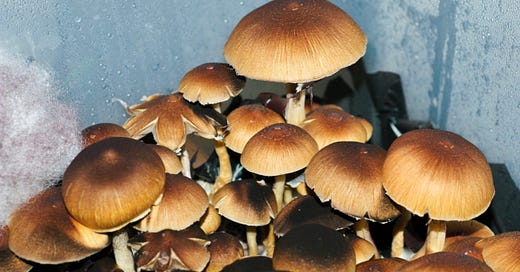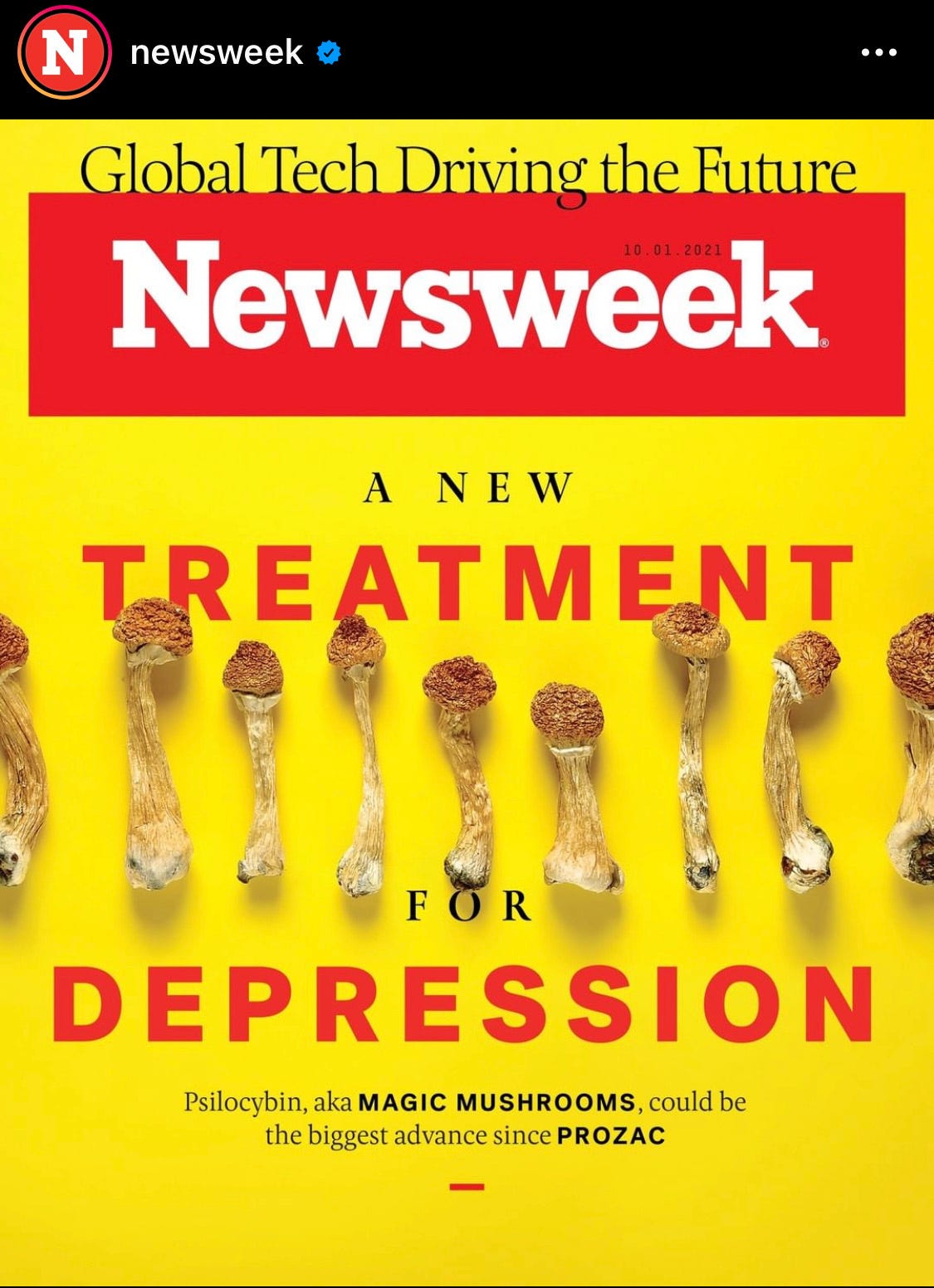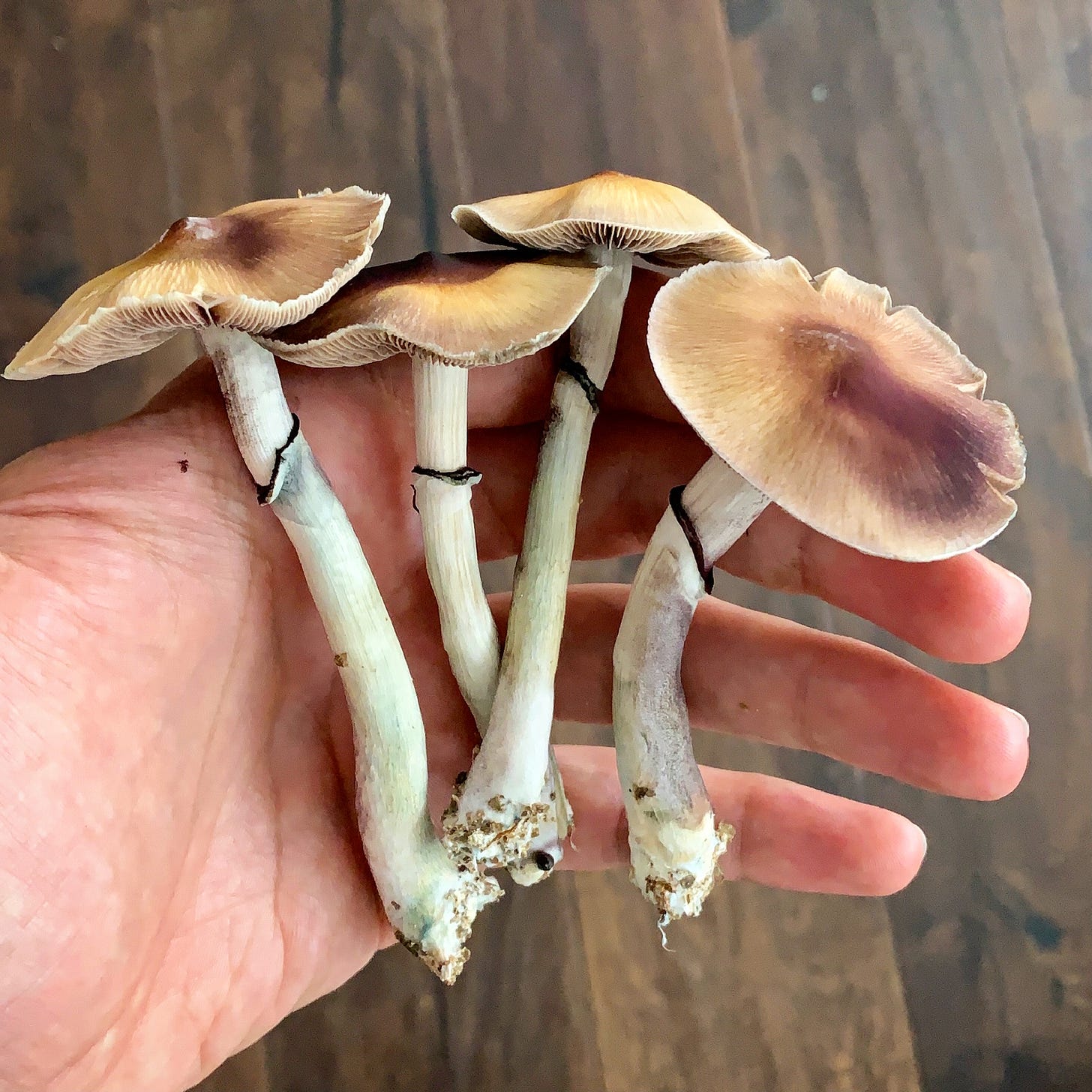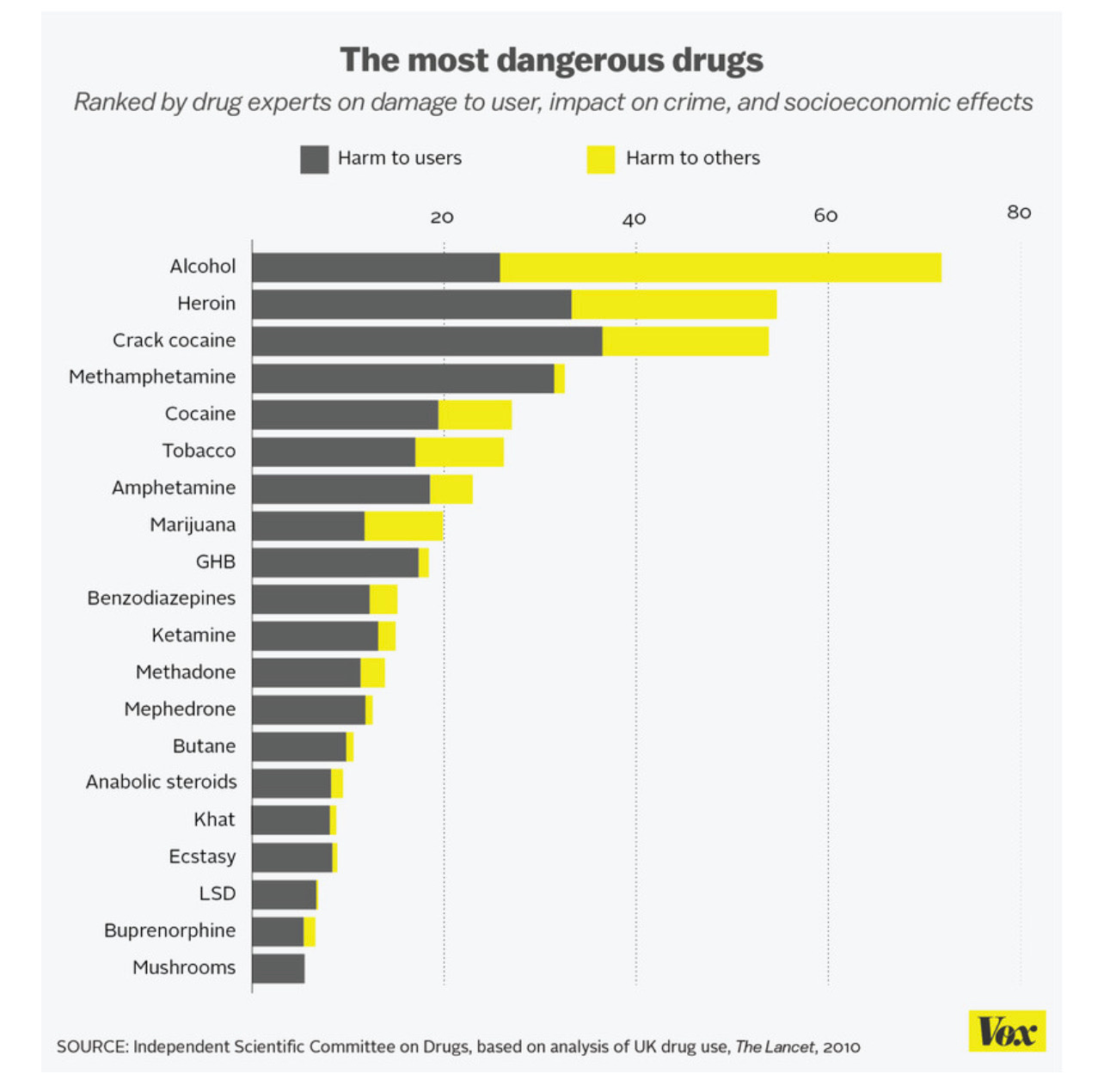In a few days, I will give a talk on Microdosing 101: Fungal Protocols for Healing at a holistic event by Wanderlust. I'm currently reviewing notes and books on hallucinogenic mushrooms as part of my preparation; as the name suggests, this time I will analyze the trend of microdosing psilocybe mushrooms. This protocol, developed decades ago by renowned scientists and mycologists like James Fadiman and Paul Stamets, has recently gained popularity due to a combination of events. On one hand, scientists have discovered that these little mushrooms have benefits for our mental health. Combine this with the fact that newer generations are increasingly open to psychedelics (and consequently, so are politicians) and that they have been destigmatized and popularized thanks to journalists, writers, and content creators (like Hamilton Morris, Michelle Janikian, or Andrew Huberman).
Mushrooms are very interesting beings. They are neither plants nor animals. They have their own kingdom. There are millions of fungi in the world, and approximately 180-200 of them are of the psilocybe type, known for their hallucinogenic effects for over 3,000 years, when they were consumed ritually, particularly by the Mayans in southern Mexico and Guatemala. There are theories suggesting that mushrooms are extraterrestrial beings that arrived on a meteorite millions of years ago as trillions of spores incubating and thousands of kilometers of mycelium attached to the space rock that struck—most likely on the Yucatan Peninsula—releasing a cosmic colonization. Thanks to oxygen, they were able to expand and sprout fruiting bodies that allowed them to reproduce across the planet, decomposing dead organic matter to fertilize the earth.
These resilient beings have served as food, been used as building and crafting materials, and been a source of physical healing (i.e., penicillin) and spiritual healing. Some are so powerful they can kill us. Others lead us to altered states of consciousness. Why? It's not known exactly. Some mycologists believe it's to ward off insects and larger predators. Others, like the great psychonaut Terence McKenna, believe that psilocybin (the precursor compound of psilocin, the psychoactive metabolite of magic mushrooms) is a technology for interspatial communication. His "Stoned Ape" theory suggests that our primate ancestors left Africa on foot, encountering abundant new flora and fauna along the way, including psilocybe. Consuming them, our ancestors experienced such a strong mental expansion that it led to an evolutionary leap.
I have a lot of respect for mushrooms. I've had very good experiences with them and some very bad ones. They've helped me expand my heart but also shown me my darkest corners. With 2 grams of mushrooms, I had a panic attack; with 4 grams, I dissolved my ego and merged with the universe. They are very powerful. That's why today I feel ambiguous whenever I address microdosing, chocolate mushrooms, and the psychedelic retreats the community (including myself) is promoting, often having forgotten their sacred essence, their ceremonial purpose. We have turned a topic that for years connected us with god, not to feel immortal but to feel like god ourselves, remembering the inner power that each of us is, into a wellness trend. That's why the Mazatec community in Oaxaca uses them to cure terminal illnesses. They are so revered that only children can pick them with their hands during full moon nights, immediately covering them with banana or corn leaves (the mushrooms cannot be seen once picked) before starting a nighttime ritual where patients receive pairs of mushrooms, as determined by the shaman, who also consumes to guide the person through various dimensions.
The first time I tried mushrooms was in New York, at my bachelor party for my first marriage, almost ten years ago. My friends bought a bag full of dry little mushrooms, and each of us grabbed a handful and started eating them little by little. They wouldn't tell me where we were going, but I asked them not to take me to a strip club, mostly due to a lack of creativity. Fortunately, they ended up taking me to Sleep No More, an interactive theater play where you're given a mask, separated from the group you arrived with, and scattered throughout a gigantic building where you have the freedom to wander, dodging extremely strange and in many cases explicit situations. You couldn't speak or interact with the audience, but in many cases, silent groups and dynamics were formed.
It was like being in a Lewis Carroll story but with scenery and a script designed by Marilyn Manson. The story was as dark as the building where it took place; it wasn't the kind of calm play you'd take your parents to. Nor highly sensitive people. Despite its intensity and challenging situations, I never felt scared. I noticed the mushrooms hit me about half an hour after entering, after a long exhale that relaxed my body and brought me peace, a feeling that accompanied me throughout the event. I enjoyed it a lot, even when witnessing violent situations. It was as if the mushrooms had removed my fear by recognizing myself as a spectator, appreciating life in all its nuances.
At least that's how I saw it with what I believe were about 2.5-3 grams of mushrooms (at that time I was a novice user and didn't weigh my drugs). My second time was much more magical because it was in Jamaica, in the middle of nature, with a group of friends with whom a beautiful connection was formed. But I'll tell that story another time. I want to emphasize that although I tried mushrooms in what technically would be the worst place to do so, I had a very beautiful experience that paved the way for my fungal exploration for many more years. I enjoyed letting go of any expectations and dedicating myself to admiring the moment.
Today I know that this pleasant sensation occurs because psilocin acts on our serotonin receptors and leads the brain to enter its original state (the Default Mode Network or DMN), allowing us to understand the world from a pure and non-judgmental perspective, in turn opening the possibility of creating new activations and neural branches to, literally, expand our minds. Probably for this reason, children are in charge of collecting the mushrooms, because only those who carry innocence in their hearts can handle that much medicine.
En unos días estaré dando una charla titulada Microdosis 101: Protocolos Fungales para Sanar durante un evento holístico organizando por Wanderlust. Ando repasando notas y libros sobre hongos halucinógenos como parte de mi preparación; como bien lo dice el nombre, en esta ocasión analizaré la tendencia de las microdosis de hongos psilocybe. Este protocolo, desarrollado hace décadas por grandes científicos y micólogos como James Fadiman y Paul Stamets, se ha popularizado recientemente debido a una combinación de sucesos. Por un lado, los científicos han descubierto que los honguitos tienen beneficios para nuestra salud mental. A esto combínenle que las nuevas generaciones están cada vez más abiertas a los psicodélicos (y por ende los políticos también), además de que se han venido desestigmatizando y popularizando gracias a periodistas, escritores y creadores de contenido (como Hamilton Morris, Michelle Janikian o Andrew Huberman).
Los hongos son seres muy interesantes. No son ni plantas ni animales. Tienen su propio reino. Existen millones de hongos en el mundo y aproximadamente 180-200 de ellos son del tipo psilocybe, conocidos por sus efectos alucinógenos desde hace más de 3,000 años, cuando eran consumidos de manera ritualística, particularmente por los mayas del sur de México y Guatemala. Hay teorías que proponen que los hongos son seres extraterrestres que llegaron en un meteorito hace millones de años como trillones de esporas incubando y miles de kilómetros de micelio adherido a la roca espacial que pegó—muy probablemente en la península de Yucatán—liberando una colonización cósmica. Gracias al oxígeno pudieron expandirse y brotar cuerpos fructíferos que les permitieron reproducirse por todo el planeta, descomponiendo materia orgánica muerta para así fertilizar la tierra.
Estos seres resilientes han servido de comida, usados como material de construcción y confección, y fuente de curación física (i.e. la penicilina) y sanación espiritual. Algunos son tan poderosos que pueden matarnos. Otros nos llevan a estados alterados de consciencia. ¿Por qué? No se sabe con exactitud. Algunos micólogos creen que es para espantar a los insectos y depredadores de mayor tamaño. Otros, como el gran psiconauta Terence McKenna, creen que la psilocibina (compuesto precursor de la psilocina, el metabolito psicoactivo de los hongos mágicos) son una tecnología de comunicación interespacial. Su teoría del Mono Drogado dice que nuestros antepasados primates salieron de África caminando, encontrando abundante flora y fauna nueva en su camino, incluyendo los psilocybe. Al ser consumidos, nuestros ancestros tuvieron una expansión mental tan fuerte que dimos un salto evolutivo.
Le tengo mucho respeto a los hongos. He tenido muy buenas experiencias con ellos y otras muy malas. Me han ayudado a expandir el corazón pero también me han mostrado mis rincones más oscuros. Con 2 gramos de hongos me dio un ataque de paranoia, con 4 gramos de hongos disolví mi ego y me fundí con el universo. Son muy poderosos. Por eso hoy en día tengo sentimientos ambiguos con el tema de las microdosis, los choco-hongos y los retiros que estamos promoviendo, muchas veces habiendo olvidado su esencia sagrada, su propósito ceremonial. Hemos vuelto tendencia wellness un tema que durante años nos conectó con dios, no para sentirnos inmortales sino para sentirnos dios mismo, recordando el poder interior que cada uno de nosotros es. Por eso la comunidad Mazateca de Oaxaca los usa para curar enfermedades terminales. Son tan venerados que solamente los niños pueden recogerlos con sus manos durante las noches de luna llena, tapándolos inmediatamente con hojas de plátano o maíz (los hongos no pueden ser vistos una vez recogidos) antes de comenzar un ritual de noche donde los pacientes reciben parejas de hongos, a manera que vaya determinando el/la chamán/a, quien también consume para guiar a la persona en varias dimensiones.
La primera vez que probé hongos fue en Nueva York, en mi despedida de soltero de mi primer matrimonio, hace casi diez años. Mis amigos compraron una bolsa llena de honguitos secos y cada uno agarró un puñado y los fuimos comiendo de a poco. No me querían decir a dónde iríamos, pero les pedí que no fuera un club de estriptis, más que nada por la falta de creatividad. Por fortuna me terminaron llevando a Sleep No More, una obra de teatro interactiva donde a uno le ponían una máscara, lo separaban del grupo con el que había llegado, y lo regaban por un edificio gigantesco por donde uno tenía libertad de vagar, esquivando situaciones sumamente extrañas y en muchos casos explícitas. No se podía hablar ni interactuar con la audiencia, pero en muchos casos se iban haciendo grupos y se iban creando dinámicas silenciosas.
Era como estar en un cuento de Lewis Carroll pero con escenografía y guion diseñado por Marilyn Manson. La historia era tan oscura como el edificio donde sucedía; no era el tipo de obra tranquila a la que uno lleva a los papás. Ni a gente altamente sensible. A pesar de su intensidad y situaciones desafiantes, nunca me sentí asustado. Noté que los hongos me habían pegado una media hora luego de entrar, luego de una larga exhalada que me distensionó el cuerpo y me trajo tranquilidad, sentimiento que me acompaño durante el evento. Lo disfruté mucho, aún cuando presencié situaciones violentas. Era como si los hongos me habían quitado el miedo a través de reconocerme como espectador, apreciado la vida en todos sus matices.
Al menos así lo vi con lo que creo fueron unos 2.5-3 gramos de hongos (en esa época era un consumidor novato y no pesaba mis drogas). Mi segunda vez fue mucho más mágica porque fue en Jamaica, en medio de la naturaleza, con un grupo de amigos con quienes se formó una hermosa conexión. Pero esa historia la contaré en otro momento. Quiero hacer énfasis en que aunque probé los hongos en lo que técnicamente sería el peor lugar para hacerlo, tuve una experiencia muy bella que pavimentó mi exploración fungal por más años. Disfruté mucho dejar de lado cualquier tipo de expectativa y dedicarme a admirar el momento.
Hoy sé que esa sensación tan placentera se da porque la psilocina actúa sobre nuestros receptores de serotonina y lleva al cerebro a entrar a su estado original (el Default Mode Network o DMN) que nos permite entender el mundo desde una perspectiva pura y sin juzgar, abriéndo a su vez la posibilidad de crear nuevas activaciones y ramificaciones neuronales para, literalmente, expandir nuestra mente. Probablemente por eso los niños son los encargados de recolectar los hongos, porque solo quien lleva la inocencia en su corazón puede lidiar con tanta medicine.







